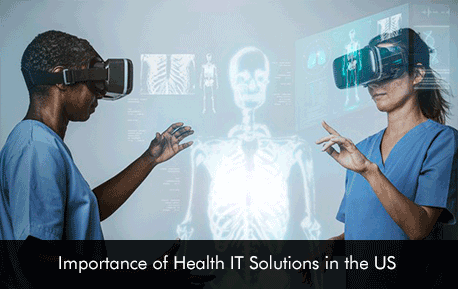Health IT and digital tools have revolutionized the way the healthcare system is operating in the United States. Telemedicine, Artificial Intelligence enables medical devices, Blockchain, Machine learning, and Electronic Medical Records (EMR) software solutions are examples of digital technologies which have helped to enhance the care process by facilitating quick diagnosis and treatment through analytical tools and digital patient records.
Through technology, doctors can streamline their workflows and patients can receive better care artificial intelligence-powered systems, software systems, and mobile access facilities. Healthcare has greatly taken advantage of IT solutions such as mobile healthcare, robotics, IoT healthcare, and telemedicine EMR software solutions in the wake of the COVID-19 pandemic. The global crisis has reshaped remote care opportunities for all population groups and segments and has enabled physicians to diagnose patients with the virus through virtual sessions.
What are digital healthcare solutions?
Patients and doctors can take benefit from the following powerful solutions,
- Schedule online appointments.
- Create electronic medical records.
- Chatbots can be used to provide information to patients when they are online.
- Patient portal EMR Software facility to connect patients and doctors.
- Billing software solutions for streamlined financial services and solutions.
- Seamless exchange of data through interoperability in the EHR software.
- Telemedicine for remote patient monitoring, treatment, and diagnosis reduces the burden on hospital systems.
Influences of digital transformation in the US healthcare industry
Digital technologies have helped to pace up the treatment process for patients with improved process organization which has resulted in lower costs.
- Enhanced services – Through health IT better services can be offered to patients. Such as the patient portal platform services provide an opportunity for patients to connect with their healthcare provider round the clock. The robust platform can also be used by patients to view their lab results and medical histories which keeps them involved in their healthcare process.
- Better analysis – Analytics tools and features in your EHR software system facilitate timely analysis of financial and patient data. AI technology helps to reduce any errors and which ultimately enhances staff productivity.
- Improvement in the organization – Cloud computing services enables data to go digital and allows quick access to patient medical records which supports the clinician’s decision-making process. Also, wearable devices can improve patient safety by alerting both patients and doctors in case of an emergency so an ambulance can be called on time.
- All-time access – With the help of electronic health records software practitioners have 24/7 access to patient data which helps them to examine patients faster and with greater precision. You don’t need to be tied at your hospital desk to view patient medical histories and other conditions.
The challenges
The main challenge associated with healthcare systems embracing technology and digital health tools is to keep patient information and data safe from cyber-attacks and ransomware attacks. Medical software developers need to address the issue of cybersecurity. Research and patient data should be protected round the clock through encryption and by staying updated with security policies.
These healthcare innovations have opened a new window for doctors to prevent diseases, keep people healthier, and enhancing the overall care process. Practitioners feel more empowered with data analytics which reaps noteworthy discoveries in healthcare management and diagnosis.







